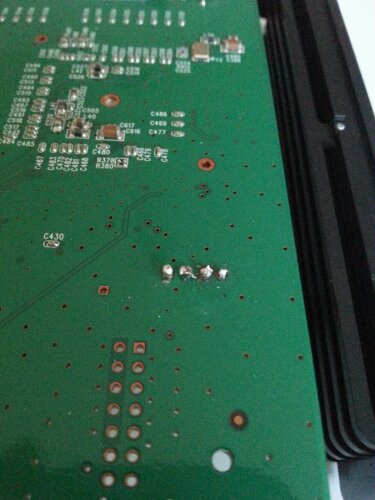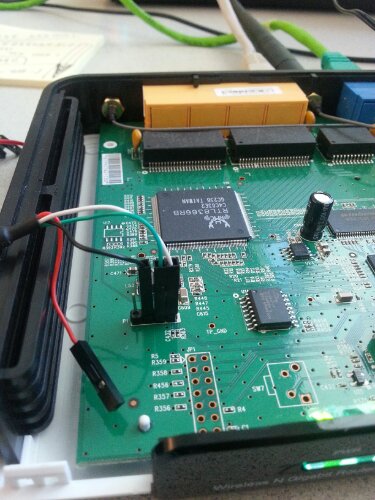Posted: July 23rd, 2013 | Author: hiren | Filed under: embedded, FreeBSD, mips, wifi, wireless | No Comments »
This is a followup post to Installing FreeBSD on TP-Link TL-WR1043ND
I’ve learned a few very basic networking things while trying to make this work.
After having FreeBSD run on the board, next thing was to make it do networking. How Adrian’s scripts work is, it has configuration in /etc/cfg/
# pwd
/etc/cfg
# ls
hostapd.wlan0.conf manifest rc.conf
#
Here,
manifest file has list of files to be stored in flash on “cfg_save”. Basic workflow is that you make changes you want and do “cfg_save” which writes things to flash and then “reboot”. So router comes up with the saved settings.
To create a wifi network for let’s say wlan0, we need to create a hostapd file for it:
# cat hostapd.wlan0.conf
interface=wlan0
driver=bsd
ssid=STRCDR_11N
wpa=3
wpa_key_mgmt=WPA-PSK
wpa_passphrase=NotAdminORPassword
wpa_pairwise=CCMP TKIP
ctrl_interface=/var/run/hostapd
As this is a new file and we want to preserve it across reboots, we should add an entry for this file into manifest file. This is how manifest file looks:
# cat manifest
etc/cfg/manifest
etc/master.passwd
etc/group
etc/cfg/rc.conf
etc/cfg/hostapd.wlan0.conf
rc.conf is where you specify your networking configuration:
# cat rc.conf
# Set the default system hostname
system_hostname="freebsd-wifi-build"
# Modules to load
kernel_modules="bridgestp if_bridge random"
# These interfaces are configured in-order
network_interfaces="arge0 wlan0 bridge0"
# Create arge0, no interface address
netif_arge0_enable="YES"
netif_arge0_type="ether"
netif_arge0_addrtype="none"
netif_arge0_descr="default"
netif_arge0_name="arge0"
# Create a bridge, flip on an IPv4 static address
netif_bridge0_type="bridge"
netif_bridge0_addrtype="static"
netif_bridge0_descr="default"
netif_bridge0_name="bridge0"
# These are bridge members w/ STP enabled
netif_bridge0_members_stp="arge0"
# These are bridge members w/ STP disabled
netif_bridge0_members="arge0 wlan0"
netif_bridge0_ipv4_address="192.168.1.20"
netif_bridge0_ipv4_netmask="255.255.255.0"
netif_wlan0_enable="YES"
netif_wlan0_type="wifi"
netif_wlan0_wifi_mode="hostap"
netif_wlan0_descr="default"
netif_wlan0_addrtype="none"
netif_wlan0_name="wlan0"
netif_wlan0_wifi_parent="ath0"
netif_wlan0_wifi_createargs1="country US regdomain FCC3"
netif_wlan0_wifi_createargs2="channel 1:ht/20 up"
netif_wlan0_wifi_hostapd_enable="yes"
netif_wlan0_wifi_hostapd_conf="/etc/cfg/hostapd.wlan0.conf"
A few things to notice here:
* arge0 is the ethernet interface
* wlan0 is the wifi interface
* bridge0 is the bridge interface connecting all of it together. It does the bridging of ethernet and wifi interfaces to send and receive bits (and bytes).
After making changes, to save them do:
# cfg_save
*** Storing configuration files from /etc/cfg/manifest -> /dev/map/cfg..
etc/cfg/manifest
etc/master.passwd
etc/group
etc/cfg/rc.conf
etc/cfg/hostapd.wlan0.conf
8 blocks
dd: /dev/map/cfg: end of device
0+2 records in
1+0 records out
65536 bytes transferred in 0.479322 secs (136726 bytes/sec)
And “reboot” the router. When it comes back, it _should_ have everything ready and setup which was not the case with my setup.
This is how interfaces looked:
# ifconfig
arge0: flags=8943 metric 0 mtu 1500
ether 64:70:02:cd:94:56
inet6 fe80::6670:2ff:fecd:9456%arge0 prefixlen 64 scopeid 0x6
nd6 options=21
media: Ethernet 1000baseT
status: active
arge1: flags=8802 metric 0 mtu 1500
ether 64:70:02:cd:94:57
nd6 options=21
media: Ethernet 100baseTX
status: active
ath0: flags=8843 metric 0 mtu 2290
ether 00:19:e0:66:66:68
nd6 options=21
media: IEEE 802.11 Wireless Ethernet autoselect mode 11ng
status: running
lo0: flags=8049 metric 0 mtu 16384
options=600003
inet6 ::1 prefixlen 128
inet6 fe80::1%lo0 prefixlen 64 scopeid 0x9
inet 127.0.0.1 netmask 0xff000000
nd6 options=21
wlan0: flags=8943 metric 0 mtu 1500
ether 00:19:e0:66:66:68
inet6 fe80::219:e0ff:fe66:6668%wlan0 prefixlen 64 scopeid 0xa
nd6 options=21
media: IEEE 802.11 Wireless Ethernet autoselect mode 11ng
status: running
ssid STRCDR_11N channel 1 (2412 MHz 11g ht/20) bssid 00:19:e0:66:66:68
regdomain FCC3 country US ecm authmode WPA1+WPA2/802.11i
privacy MIXED deftxkey 3 TKIP 2:128-bit TKIP 3:128-bit txpower 30
scanvalid 60 protmode CTS ampdulimit 64k ampdudensity 8 shortgi wme
burst dtimperiod 1 -dfs
bridge0: flags=8843 metric 0 mtu 1500
ether 96:ce:f3:c8:09:b4
inet 192.168.1.20 netmask 0xffffff00 broadcast 192.168.1.255
nd6 options=21
id 00:00:00:00:00:00 priority 32768 hellotime 2 fwddelay 15
maxage 20 holdcnt 6 proto rstp maxaddr 2000 timeout 1200
root id 00:00:00:00:00:00 priority 32768 ifcost 0 port 0
member: wlan0 flags=143
ifmaxaddr 0 port 10 priority 128 path cost 33333
member: arge0 flags=143
ifmaxaddr 0 port 6 priority 128 path cost 2000000
#
As you can see everything looked sane and I could see it advertizing wifi network but when a client tries to associate, it would get stuck on “Obtaining IP address” and even if you assign static IP, client does not receive any packets.
We then looked at “etherswitchcfg” which provides ethernet connectivity for the board:
# etherswitchcfg
port0:
vlangroup: 1
media: Ethernet autoselect (100baseTX )
status: active
port1:
vlangroup: 0
media: Ethernet autoselect (none)
status: no carrier
port2:
vlangroup: 0
media: Ethernet autoselect (none)
status: no carrier
port3:
vlangroup: 0
media: Ethernet autoselect (none)
status: no carrier
port4:
vlangroup: 0
media: Ethernet autoselect (none)
status: no carrier
port5:
vlangroup: 0
media: Ethernet 1000baseT
status: active
vlangroup0:
vlan: 1
members 1,2,3,4,5
vlangroup1:
vlan: 2
members 0,5t
#
Now, as you can see the ethernet cable in WAN (blue) port shows up as port0 and it is in vlangroup1. But vlangroup1 is in vlan 2 and it is tagged. Moving ethernet cable from WAN port to one of the LAN ports fixed the problem.
# etherswitchcfg
port0:
vlangroup: 1
media: Ethernet autoselect (none)
status: no carrier
port1:
vlangroup: 0
media: Ethernet autoselect (100baseTX )
status: active
port2:
vlangroup: 0
media: Ethernet autoselect (none)
status: no carrier
port3:
vlangroup: 0
media: Ethernet autoselect (none)
status: no carrier
port4:
vlangroup: 0
media: Ethernet autoselect (none)
status: no carrier
port5:
vlangroup: 0
media: Ethernet 1000baseT
status: active
vlangroup0:
vlan: 1
members 1,2,3,4,5
vlangroup1:
vlan: 2
members 0,5t
#
Now a client could associate and get an IP via dhcp from the incoming ethernet connection on the router. (No dhcpd is needed/running on the router itself).
To look at connected clients:
# ifconfig wlan0 list sta
ADDR AID CHAN RATE RSSI IDLE TXSEQ RXSEQ CAPS FLAG
08:11:96:f9:b2:ec 1 1 144M 38.5 0 4012 27616 EPS AQEHTRS RSN HTCAP WME
To debug, we can look at individual ports with “tcpdump -ni “.
Verbose debugging from ath wifi stack can be obtained by:
# wlandebug -i wlan1 +assoc
net.wlan.1.debug: 0x0 => 0x800000
Just as a side-note, hostapd proc is using the configuration we provided and is running:
# ps awwux | grep hostapd
root 176 0.0 6.6 13104 2176 - Ss 6:56PM 0:00.13 hostapd -P /var/run/hostapd.wlan0.pid -B /etc/cfg/hostapd.wlan0.conf
Again a *HUGE* Thanks to Mr FreeBSD Wifi (Adrian Chadd) for all the build scripts and help with the bring-up.
Posted: July 1st, 2013 | Author: hiren | Filed under: FreeBSD, wifi, wireless | Tags: wifi mips embedded | 11 Comments »
I decided to play with some wireless router and put FreeBSD on it. Adrian suggested TL-WR1043ND so I bought it.
I’ve used Adrian Chadd’s scripts do this. All the commands for flashing is also from him. A *huge* thanks to him.
I’ve also referenced OpenWRT page a lot.
Serial connection was the first thing I had to determine. Figured out serial pinouts from the OpenWRT page. Did my first soldering job:

Got usb to ttl serial cable to connect to the tx, rx and gnd pins.

After having serial connection setup, next thing was to load FreeBSD on it. (It comes with preloaded linux on it.) I grabbed image building tool from Adrian Chadd’s scripts and generated an image out of freebsd-head suitable for this board: TP-WN1043ND.factory.bin
Now, what you do is, plug usb end of the serial cable into laptop which FreeBSD presents as a cuaUN device. (Check your dmesg o/p to know value of “N”)
Connect to it via:
#cu -s 115200 -l /dev/cuaU0
Now power on the router and interrupt the boot process by typing “tpl” to drop into “uboot” prompt.
uboot looks like this:
ar7100> printenv
bootargs=console=ttyS0,115200 root=31:02 rootfstype=jffs2 init=/sbin/init mtdparts=ar9100-nor0:128k(u-boot),1024k(kernel),4096k(rootfs
),64k(art)
bootcmd=bootm 0xbf020000
bootdelay=1
baudrate=115200
ethaddr=00:1D:0F:11:22:33
ipaddr=192.168.0.2
serverip=192.168.0.5
stdin=serial
stdout=serial
stderr=serial
ethact=eth0
Environment size: 317/131068 bytes
Now starts the fleshing of firmware part. The first step below is *VERY* important…
# This erases the flash between uboot and the firmware configuration area. Whatever you do, don't mistype this!
erase 0xbf020000 +7c0000
Now, we should setup the tftp part so that we can get image we prepared from tftpserver (laptop) to tftpclient (router board). uboot is very specific about the IP addresses of both server and client. As per “printenv”, server IP *must* be 192.168.0.5 so assign that IP to the ethernet interface (via ifconfig alias). Run a network cable from laptop to one if the LAN ports of the router. (Original instructions suggest using the WAN port which did not work for me (because of which I wasted 2 frustrating weeks debugging)). Start tftpserver on laptop and copy prepared image in respective location (/tftpboot by default)
Let’s transfer/copy the image to router via tftp into RAM:
ar7100> tftpboot 0x81000000 TP-WN1043ND.factory.bin
dup 1 speed 1000
Using eth0 device
TFTP from server 192.168.0.5; our IP address is 192.168.0.2
Filename 'TP-WN1043ND.factory.bin'.
Load address: 0x81000000
Loading: T T T T T T T T #################################################################
#################################################################
#################################################################
#################################################################
#################################################################
#################################################################
#################################################################
#################################################################
#################################################################
#################################################################
#################################################################
#################################################################
#################################################################
#################################################################
#################################################################
#################################################################
#################################################################
#################################################################
#################################################################
#################################################################
#################################################################
#################################################################
#################################################################
#################################################################
############################
done
Bytes transferred = 8126464 (7c0000 hex)
Next step is to copy firmware image from RAM to the flash.
cp.b 0x81000000 0xbf020000 0x7c0000
Let’s boot the damn thing 
bootm 0xbf020000
## Booting image at bf020000 ...
Uncompressing Kernel Image ... OK
Starting kernel ...
CPU platform: Atheros AR9132 rev 2
CPU Frequency=400 MHz
CPU DDR Frequency=400 MHz
CPU AHB Frequency=200 MHz
platform frequency: 400000000
arguments:
a0 = 00000007
a1 = a1f77fb0
a2 = a1f78440
a3 = 00000008
Cmd line:argv is invalid
Environment:
envp is invalid
Cache info:
picache_stride = 4096
picache_loopcount = 16
pdcache_stride = 4096
pdcache_loopcount = 8
cpu0: MIPS Technologies processor v116.147
MMU: Standard TLB, 16 entries
L1 i-cache: 4 ways of 512 sets, 32 bytes per line
L1 d-cache: 4 ways of 256 sets, 32 bytes per line
Config1=0x9ee3519e
Config3=0x20
KDB: debugger backends: ddb
KDB: current backend: ddb
Copyright (c) 1992-2013 The FreeBSD Project.
Copyright (c) 1979, 1980, 1983, 1986, 1988, 1989, 1991, 1992, 1993, 1994
The Regents of the University of California. All rights reserved.
FreeBSD is a registered trademark of The FreeBSD Foundation.
FreeBSD 10.0-CURRENT #0 r248805M: Wed Dec 31 16:00:00 PST 1969
hirenp@dummy:/home/hirenp/work/freebsd/head/obj/mipseb/mips.mips/usr/home/hirenp/work/freebsd/head/src/sys/TP-WN1043ND mips
gcc version 4.2.1 20070831 patched [FreeBSD]
WARNING: WITNESS option enabled, expect reduced performance.
real memory = 33554432 (32768K bytes)
avail memory = 24944640 (23MB)
random device not loaded; using insecure entropy
nexus0:
clock0: on nexus0
Timecounter "MIPS32" frequency 200000000 Hz quality 800
Event timer "MIPS32" frequency 200000000 Hz quality 800
apb0 at irq 4 on nexus0
uart0: <16550 or compatible> on apb0
uart0: console (115200,n,8,1)
gpio0: on apb0
gpio0: [GIANT-LOCKED]
gpio0: function_set: 0x2000
gpio0: function_clear: 0x0
gpio0: gpio pinmask=0x1c02ae
gpioc0: on gpio0
gpiobus0: on gpio0
gpioled1: at pin(s) 2 on gpiobus0
gpioled2: at pin(s) 5 on gpiobus0
gpioled3: at pin(s) 9 on gpiobus0
gpioiic0: at pin(s) 18-19 on gpiobus0
iicbb0: on gpioiic0
iicbus0: on iicbb0 master-only
iic0: on iicbus0
rtl8366rb0: at addr 0xa8 on iicbus0
rtl8366rb0: rev. 3
miibus0: on rtl8366rb0
ukphy0: PHY 0 on miibus0
ukphy0: none, 10baseT, 10baseT-FDX, 100baseTX, 100baseTX-FDX, 1000baseT-FDX, 1000baseT-FDX-master, auto
miibus1: on rtl8366rb0
ukphy1: PHY 1 on miibus1
ukphy1: none, 10baseT, 10baseT-FDX, 100baseTX, 100baseTX-FDX, 1000baseT-FDX, 1000baseT-FDX-master, auto
miibus2: on rtl8366rb0
ukphy2: PHY 2 on miibus2
ukphy2: none, 10baseT, 10baseT-FDX, 100baseTX, 100baseTX-FDX, 1000baseT-FDX, 1000baseT-FDX-master, auto
miibus3: on rtl8366rb0
ukphy3: PHY 3 on miibus3
ukphy3: none, 10baseT, 10baseT-FDX, 100baseTX, 100baseTX-FDX, 1000baseT-FDX, 1000baseT-FDX-master, auto
miibus4: on rtl8366rb0
ukphy4: PHY 4 on miibus4
ukphy4: none, 10baseT, 10baseT-FDX, 100baseTX, 100baseTX-FDX, 1000baseT-FDX, 1000baseT-FDX-master, auto
etherswitch0: on rtl8366rb0
ehci0: at mem 0x1b000100-0x1bffffff irq 1 on nexus0
usbus0: set host controller mode
usbus0: EHCI version 1.0
usbus0: set host controller mode
usbus0 on ehci0
arge0: at mem 0x19000000-0x19000fff irq 2 on nexus0
arge0: Overriding MAC from EEPROM
arge0: finishing attachment, phymask 0000, proxy null
arge0: Ethernet address: 64:70:02:cd:94:56
arge1: at mem 0x1a000000-0x1a000fff irq 3 on nexus0
arge1: finishing attachment, phymask 0000, proxy null
arge1: Ethernet address: 64:70:02:cd:94:57
ath0: at mem 0x180c0000-0x180effff irq 0 on nexus0
ath0: eeprom @ 0x1fff1000
ath0: eeprom data @ 0xbfff1000
ath0: [HT] enabling HT modes
ath0: [HT] 2 RX streams; 2 TX streams
ath0: AR9130 mac 20.1 RF2133 phy 10.2
ath0: 2GHz radio: 0x0000; 5GHz radio: 0x00d0
spi0: at mem 0x1f000000-0x1f00000f on nexus0
spibus0: on spi0
mx25l0: at cs 0 on spibus0
mx25l0: s25sl064a, sector 65536 bytes, 128 sectors
ar71xx_wdog0: on nexus0
ar71xx_wdog0: Previous reset was due to watchdog timeout
Timecounters tick every 1.000 msec
rtl8366rb0port0: link state changed to DOWN
rtl8366rb0port1: link state changed to DOWN
rtl8366rb0port2: link state changed to DOWN
rtl8366rb0port3: link state changed to DOWN
rtl8366rb0port4: link state changed to DOWN
usbus0: 480Mbps High Speed USB v2.0
ugen0.1: at usbus0
uhub0: on usbus0
map/rootfs.uzip: 1123 x 16384 blocks
hwpmc: SOFT/16/64/0x67 MIPS24K/2/32/0x1ff
WARNING: WITNESS option enabled, expect reduced performance.
Root mount waiting for: usbus0
uhub0: 1 port with 1 removable, self powered
Trying to mount root from ufs:map/rootfs.uzip []...
warning: no time-of-day clock registered, system time will not be set accurately
May 24 18:55:57 init: login_getclass: unknown class 'daemon'
rtl8366rb0port1: link state changed to UP
*** Populating /var ..
*** Loading configuration files ..
*** Restoring from /dev/map/cfg ..
gunzip: unknown compression format
1+0 records in
1+0 records out
65536 bytes transferred in 0.088297 secs (742223 bytes/sec)
0 blocks
*** Completed.
*** setting up hostname
*** Load kernel modules
kldload: can't load bridgestp: File exists
kldload: can't load if_bridge: No such file or directory
kldload: can't load random: File exists
*** bringing up loopback ..
*** Starting networking via /etc/rc.d/base/net
dev.ath.0.txq_mcastq_maxdepth: 512 -> 32
sysctl: unknown oid 'dev.ath.1.txq_mcastq_maxdepth': No such file or directory
*** Interface: arge0: start
*** Interface: arge0: done
*** Interface: bridge0: start
bridge0: Ethernet address: 9e:de:f8:cb:67:4f
arge0: promiscuous mode enabled
bridge0: link state changed to UP
*** Interface: bridge0: done
*** Default password/login databases ..
*** inetd
*** Done!
FreeBSD/mips (freebsd-wifi-build) (ttyu0)
# df -k
Filesystem 1024-blocks Used Avail Capacity Mounted on
map/rootfs.uzip 17695 16769 -489 103% /
devfs 1 1 0 100% /dev
/dev/md0 828 8 756 1% /tmp
/dev/md1 828 56 708 7% /var
/dev/md2 828 436 328 57% /etc
#
Next up is _actually_ using this thing: creating wireless network and other fun stuff.



